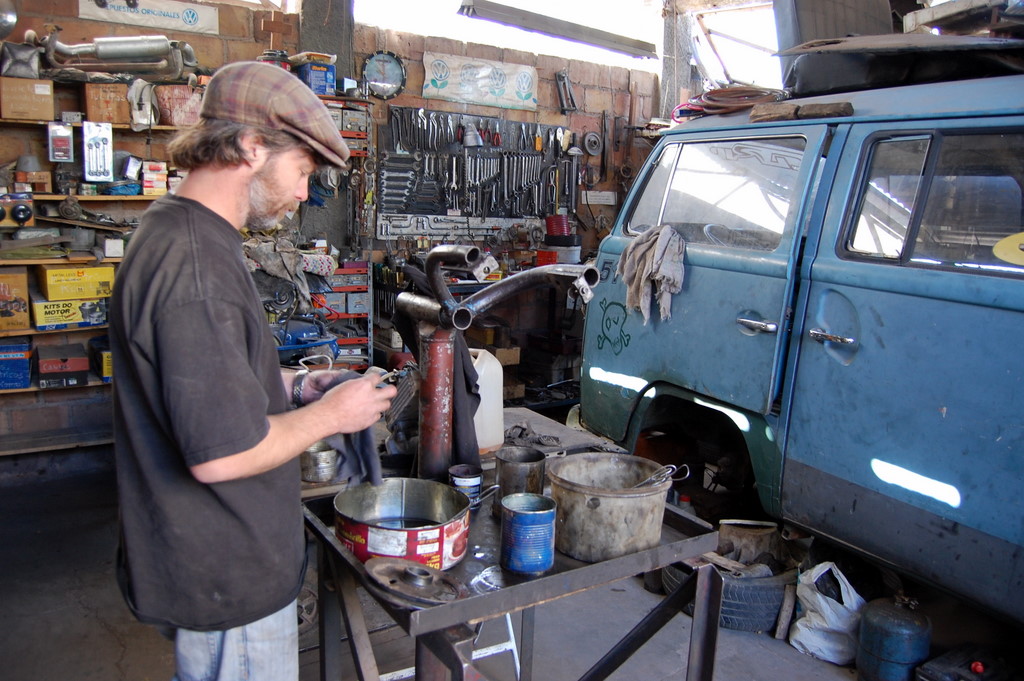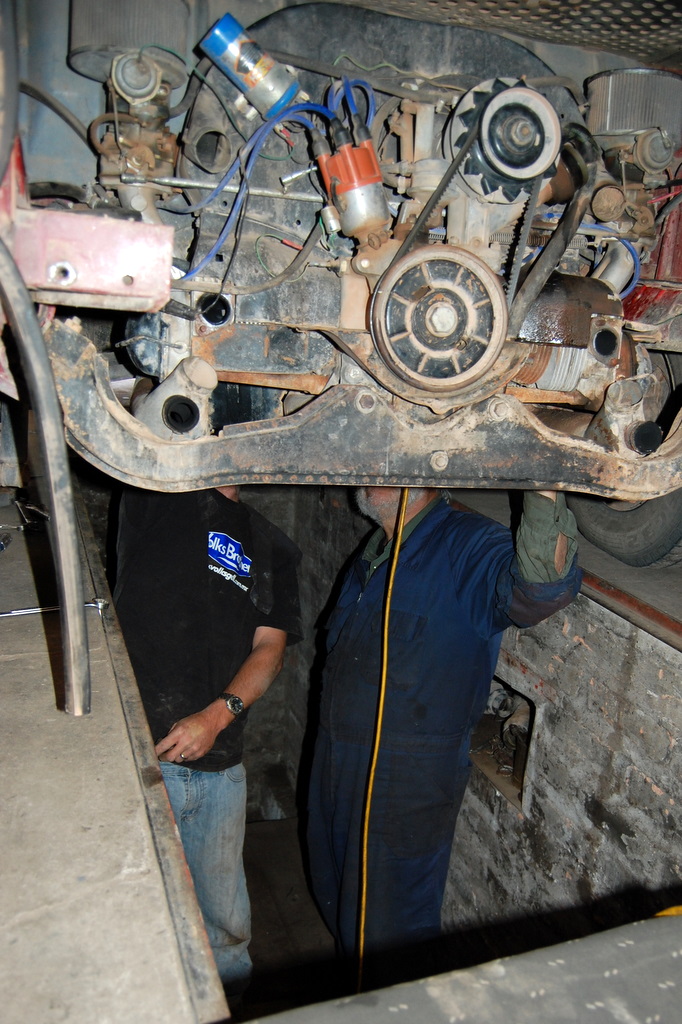Engine Out!
Beto and his wife Kuki welcomed us with open arms, fed us, and let us pop the top in their driveway until we could figure out what to do next.
The next morning, after rearranging several VW’s, we pulled the bus into the shop and dropped the engine. After a few hours, everything was apart and we even split the case – too much play in the crank. The front main bearing (thrust bearing?) was a little wobbly, so this means we will have to line-bore the case.
The increasing oil consumption and low compression also meant that we would re-do the heads and piston/cylinders too. We knew we would do at least this from the beginning. Overall, a pretty major overhaul, considering it’s our house and we’re stuck until it’s all completed.
In all, we got somewhere around 30K miles on the new engine we bought in Portland. Sure, we ventured to some pretty extreme locations, but the engine didn’t have any idea where we were. We changed the oil continuously, adjusted the valves and tuned it up religiously. The bearings wore out after 30K because… ?
If we were in the U.S. and lived in an actual permanent home, this wouldn’t be such a big deal. Transport yourself thousands of miles from home, where you don’t really speak the language, don’t know anyone, don’t know how or where to get things done, and are sleeping the vehicle you are about to remove the engine from… and well, it’s a slightly bigger deal.
Anyway, the really cool thing is that we’ve got help. We had never met Beto and only corresponded by email a day prior. He doesn’t know us from Adam. Now, we’re sleeping in his driveway (they offered a bedroom,) we’re sharing dinner, vino and mate, Bode is best friends with the dogs (Tobi and Gala circle the bus at night waiting for him to come out and play). And, we’re communicating (often poorly) solely in Spanish.
Every so often I venture outside of my normal thought process and wonder, “How the Hell did I get here?” Not literally – I know the answer to that one – but in the bigger scheme of life, you have to appreciate all the random or unplanned events that shape your future. Often, your entire life. Somewhere in here was one of those moments… and it’s pretty awesome.
Since the engine was out, apart and diagnosed before lunch, all we had to do now was take a 4 hour lunch break. We went to the park, sipped some more mate, then returned to the shop and cleaned up.
We’ll deliver everything to Beto’s favorite machine shop in the morning.









1. bode’s smirk (on the carousel) looks A LOT like a smirk i’ve seen on jason’s face from time to time.
2. i think jason’s hair may be mullet-able. can you try that please?
…always the cursed 3rd cylinder on VWs. Good luck with everything – we know what it feels like from being in a very similar situation in Bogota (it took so long that we refer to that period as “when we lived in Bogota”) – hope your rebuild goes smoothly and will be a complete success! fingers Xed.
So I take it then from the above post, that you are surprised by the fact that you have to do an engine tear-down at 30K ?….
I know I would be, and given all the other associated engine problems you’ve had along the way……..hmmm I don’t know…..
are you thinking that you got short changed on your “new engine” in Portland ?
And I realize hindsight is 20/20…but looking back on events thus far….what could you or would you have changed to prevent this engine rebuild ?
Just curious………
Cheers,
Glen
Sanford, Manitoba
aka VW Busman
Glen- We certainly thought we would get more than 30K from a new engine. Not sure what we could have done differently, so am a little perplexed. We could not have possibly changed the oil more often, adjusted the valves more often, checked tuning more often, etc.
One theory is that because of our frequent off-road driving and the additional air scoops, that significantly more dust is getting sucked into the engine compartment compared to a normal bus. Despite the filters and frequent oil changes, we still could run ‘dirtier’ than the typical bus. I suppose it makes sense, but we don’t have any actual evidence to confirm that’s really the cause.
If anyone has another reasonable answer, we’d love to hear it. I hope the rebuild get’s us much further…
Jason I have a theory, maybe even a reasonable answer. You can take it with a grain of salt if you like, or in your case a grain of sand, (which in your case is part of the problem.)
A few posts back I saw a picture of your engine, and you are running dual carbs with paper air cleaners I believe.
If I was where you are and running in those conditions, I would for sure be using an oil bath air cleaner. When I started driving VW’s back in the dinosaur age, all my VW’s came with oil bath air cleaners. They are a tad more maintenance too be sure but I think they may net you an extra 25 – 30 K out of that motor.
Here is a little snippet I sourced from the internet that explains it way more meaningful than I could write………..
“An oil bath air cleaner consists of a sump containing a pool of oil, and an insert which is filled with fibre, mesh, foam, or another coarse filter media. When the cleaner is assembled, the media-containing body of the insert sits a short distance above the surface of the oil pool. The rim of the insert overlaps the rim of the sump. This arrangement forms a labyrinthine path through which the air must travel in a series of U-turns: up through the gap between the rims of the insert and the sump, down through the gap between the outer wall of the insert and the inner wall of the sump, and up through the filter media in the body of the insert. This U-turn takes the air at high velocity across the surface of the oil pool. Larger and heavier dust and dirt particles in the air cannot make the turn due to their inertia, so they fall into the oil and settle to the bottom of the base bowl. Lighter and smaller particles are trapped by the filtration media in the insert, which is wetted by oil droplets aspirated there into by normal airflow.
Oil bath air cleaners were very widely used in automotive and small engine applications until the widespread industry adoption of the paper filter in the early 1960s. Such cleaners are still used in off-road equipment where very high levels of dust are encountered, for oil bath air cleaners can sequester a great deal of dirt relative to their overall size without loss of filtration efficiency or airflow. However, the liquid oil makes cleaning and servicing such air cleaners messy and inconvenient, they must be relatively large to avoid excessive restriction at high airflow rates.”
Now the only 2 caveats are extra maintenance and some air flow restrictions at high air flow. Your motor is not a high flow candidate. If your were running a huge high HP 400+ cu in motor this would be a concern, not so for you.
One of the main reasons the automotive wizards went to paper air filters was for..you guessed it…ease and convenience. Heaven forbid you should have to spend an extra 10 mins servicing your vehicle.
In normal urban settings, cities…paper filters work just fine.
But..where you are..driving thru deserts, sandstorms, where there is a high concentration of air borne particulate matter..an oil bath air cleaner is your best bet.
I would convert those paper filters to oil bath ones. In your locale, I would think there is still a high percentage of older ACVW’s with oil bath air cleaners. I’ve seen some of your emergency roadside fix its, this will be a no brainer for you to cobble together.
I’m also going to out on a limb and suggest the interior of your carbs have also been scoured and sandblasted, messing up any sort of venturi settings you may think you have. With the particulate matter that has gone thru your engine, it’s basically like taking a 220 wet grit sandpaper to each and every internal moving part.
I’ll get off my soap box now. My 2 cents worth.
Just saying…..
Best of luck with the rebuild.
I’m pullin for ya,
Cheers
Glen
Sanford, Manitoba, Canada
I agree about the air filters-oil bath is best, K&Ns are the only answer with those accursed Kadrons. Also, the dual Kadrons have a very ineffecient range of flow and thus are always flooding the pistons with too much gas causing extreme ring wear and loss of oil control. Using synthetic oil would help a lot plus it does not get thin when over heated. The only cure for line bore early problems is complete engine balancing-the pistons, rods and crank and flywheel with the clutch on it make my engines never need line bores and eliminate bearing wear due to flexing. If possible get the sodium filled exhaust valves with the 914-1700 valve guides to never worry again. Also the number three myth ended in 1971 with the offset oil cooler-even ducting to all cyls. Do you still have a centrifical distributer with no vac chamber? It must be timed with a light to no more than 28 degrees total advance to avoid short engine life, especially in the third world. Also while down try to get the super tin (type 3) cyl air duct that goes under the middle of the two cyls on each side-replacing the 4X4 inch one- really stops those uneven cooling blues. Plus keep the cooler well sealed and ducted and clean to ensure longer life. I also hemi-cut the inside chambers of both heads and thus have no pinging or detonation even with Mexican regular!
A couple more observations after looking at the pix closer- you should replace the rubber input fuel line with the proper steel one for safety and better flow with less chance of collapse. Also a good inline filter (I use the Honda old car ones) BEFORE the fuel pump. Also I saw good Brazilian liner sets on his shelf- when putting them on make sure to not only use the gasgets on the base but use high temp RTV -silicone to prevent leaks when expansion takes place. Also a dollop of the same RTV under the washers on the head studs inside the valve covered area (lower 4 on each side) will stop crankcase pressure leaks pushing oil out the studs as they are skinnier than the holes in the heads . Try to assure that the vent/pressure relief outlet in the oil filler black assembly goes to a suction inlet to an air filter-this alone will boost mileage and cut oil consumption plus gain power and less resistance and ring back push. The water vapor produced in the engine will also lower octane needs a bit and make it cleaner.